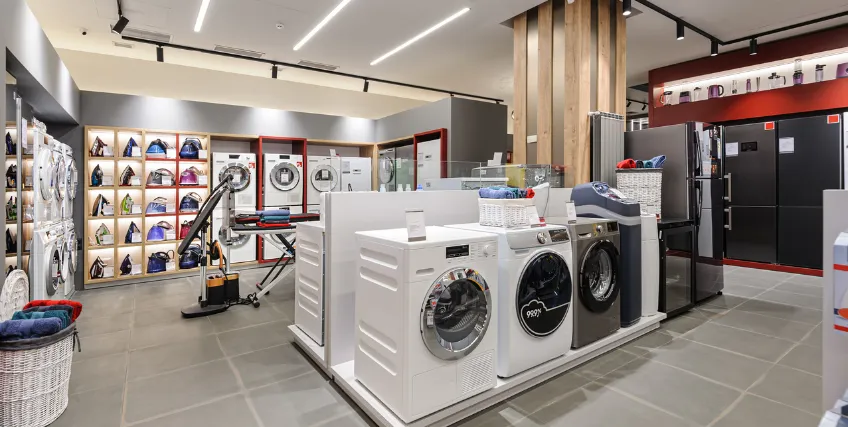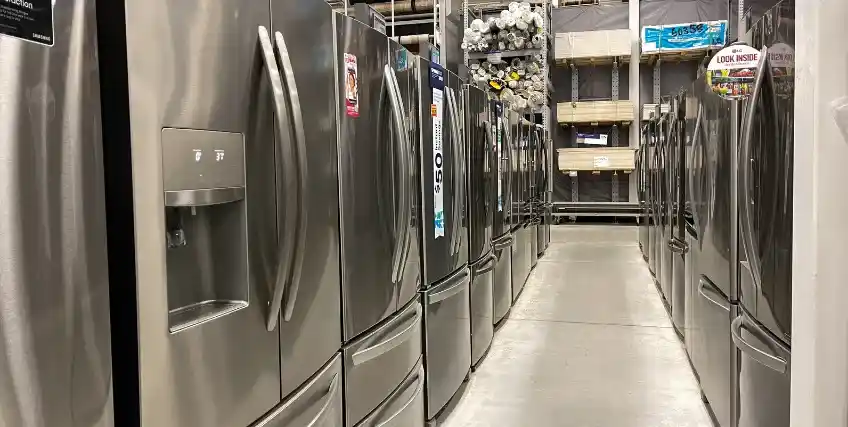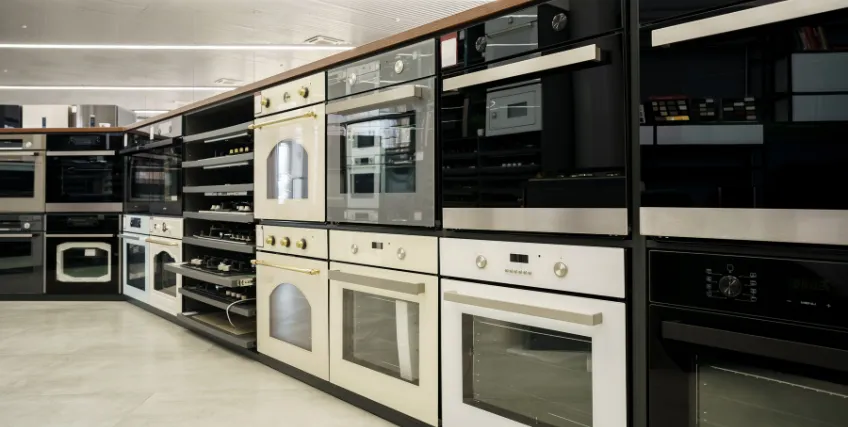Understanding Interest Rates and Terms in Appliance Financing Options
Sep 25, 2025 | Last Updated on: Sep 29, 2025

As a small business owner in the U.S., who owns an appliance store, you must be dealing with a lot of day-to-day challenges. Imagine, a customer walks into your store and is ready to buy a washer and dryer combo. He is excited but hesitant at the same time because he sees the price. This is the story of several customers for whom big purchases like major appliances often feel overwhelming.
Now, if you as a retailer could offer them flexible payment options like buy now pay later or monthly payments option, they would likely checkout with confidence. However, the problem that arises is, you as a business owner also need to manage your own costs like inventory, payroll, rent, and expansion.
Hence, the easy way out to all these problems is seeking appliance financing options for your store. For appliance retailers in the U.S., these different types of financing options for appliance stores can make a lot of difference between steady growth and missed opportunities. But before seeking any loan option, you need to understand the loan terms, interest rates, and the type of appliance financing option you need for your business.
In this article, we’ll understand the different aspects of appliance financing options for business owners, including the loan terms and interest rates, so you can make smarter financial decisions for your business.
What Are Appliance Financing Options for Business Owners?
Appliance financing options for business owners give easy access to capital so they can stock more products, expand, or manage slow seasons. In simple terms, these loan options are ways to secure funds that you need to keep your store operational and competitive.
You can think of it this way, appliance financing with no interest or low-cost repayment plans can act as a bridge between your business goals and reality. No matter if you need to buy appliances in bulk before holiday sales or secure countertop items like toaster ovens and microwaves for daily demand, having access to funding ensures you never miss out on opportunities.
Therefore, appliance financing options for retailers aren’t just about covering daily expenses, it’s about giving businesses the flexibility to grow at the right time.
Types of Appliance Financing Options
Here are different types of loans that you can consider for your appliance store. You can choose any of the appliance loan options, depending on your financial situation and growth goals.
- SBA Loans: SBA loans are government-backed loans that often support small businesses. These loans are great for working capital, business expansion, or refinancing debt. However, the application process can take a bit of time, but the rates are usually attractive.
- Term Loans: Term loans offer a lump sum loan amount that can easily be repaid in installments. These loans are ideal for bulk purchases like inventory of kitchen appliances, dishwashers, or wall ovens.
- Equipment Loans: Equipment loans can be used to purchase new appliances with financing like delivery vans, cooktops, or countertop displays. Here, the equipment itself servs as collateral, reducing the risk for lenders.
- Working Capital Loans: Working capital loans help you handle daily expenses like payroll, rent, or utility bills. If your foot traffic slows down, these loans help keep your business running.
- Business Line of Credit: A line of credit works similar to a credit card, where you can withdraw funds when needed. However, you pay the interest only on what you use. These loans are handy for unexpected expenses like repairs or seasonal spikes in toaster ovens or microwaves.
Importance of Appliance Financing Options for Businesses
As we all know that the U.S. home appliance market keeps growing, with sales driven by both essential products and upgrades. Customers typically want washers, dryers, dishwashers, fryers, and even premium kitchen appliances like KitchenAid mixers. But, the main problem is that many of them can’t even pay the full purchase amount up front.
As a retailer in the U.S., appliance financing options matter because:
- They help you keep inventory fresh and ready.
- With the right appliance financing option, you won’t miss out on customer demand during peak shopping seasons.
- With funds you can expand into categories like countertop appliances, wall ovens, or combo units without waiting years to save.
- Also, business loans help you create flexibility for yourself, much like you do for customers who prefer buy now pay later options.
Moreover, with appliance financing options for your business, you can think about rebates and promotions. You can use funds for marketing campaigns as customers often respond to deals that combine a down payment with easy installments. Hence, business financing options like SBA loans, term loans, or equipment financing help you secure bulk appliance purchases without straining your cash reserves.
Breaking Down Interest Rates in Appliance Financing
Before considering any appliance financing option for your business, take time to understand that interest rates are central to every loan option. They typically define the real cost of borrowing and understanding them helps you decide which loan structure works best for your business.
Factors Influencing Interest Rates
Here are the different factors that often influence interest rates when seeking business financing.
Business Credit Score
- A business credit score reflects how reliable your business is at repaying loans.
- Higher credit scores may mean lower interest rates and better loan terms.
Type of Loan
- Decide which appliance financing option suits that best for your business. For example, term loans might be suitable for big purchases, a business line of credit for operations, and equipment loans for targeted financing for kitchen appliances or delivery vehicles.
- Choosing the right type of loan affects your monthly payments and overall interest costs.
Application Process and Lender Assessment
- Lenders often review your loan application, financial records, and sometimes personal credit.
- They typically want assurance that your store generates enough revenue to cover installments.
- A thorough, accurate loan application improves your approval chances and may lower your interest rates.
Collateral Offered
- Offering collateral reduces the risk for the lenders.
- It often leads to better loan terms and lower interest rates.
- Also, without collateral, lenders may require higher monthly payments or stricter eligibility conditions.
Business Revenue and Cash Flow
- Lenders consider sales patterns and seasonal fluctuations.
- Reliable cash flow makes it easier to qualify for higher loan amounts.
- Example: Higher holiday sales of dishwashers, toaster ovens, or microwaves can strengthen your application.
Therefore, interest rates for appliance financing options can be fixed or variable. This means, with fixed interest rates, you can have predictability, while variable interest rates may start low but change over time.
Key Loan Terms Retailers Must Understand
Besides interest rates, loan terms also tell you how appliance financing options will impact your day-to-day operations.
Key terms include:
- Loan Duration: Short-term loans mean higher monthly payments but less interest over time. Long-term loans ease cash flow but add cost.
- Repayment Schedule: Some loans are weekly, some monthly. Hence, always match them with your sales cycle.
- Grace Periods: Certain lenders give you time before repayment starts. This helps after a big appliance purchase.
- Down Payment: Some loans require upfront cash. For example, with an equipment loan, you may need to cover part of the purchase amount.
- Credit Check: Your credit score influences both approval and interest rates.
- Prepayment Penalties: Paying early sometimes triggers prepayment penalty fees.
- Fees and Disclosures: Sometimes origination fees, processing fees, and hidden charges add to the total.
The Bottom Line
Now we can say that, appliance financing options aren’t just a tool. They’re a pathway for growth, flexibility, and stability in your appliance business. Whether it’s stocking new washers, dryers, dishwashers, or premium kitchen appliances like cooktops and wall ovens, the right appliance loan makes big purchases manageable.
However, the only important thing that you need to pay attention is interest rates, loan terms, monthly payments, and credit checks. All these factors ensure that each financing choice strengthens, rather than strains, your business.
You can explore different types of financing from SBA loans and term loans to equipment loans and business lines of credit. These appliance financing options will help you keep inventory moving, take advantage of supplier rebates, and offer customers attractive buy now pay later options.
So, take control of your store’s growth today. You can compare lenders, check your eligibility, and choose the appliance financing options that align with your goals.
FAQs About Interest Rates and Loan Terms for Appliance Financing Options
What types of appliance financing options are available for small business owners?
There are several ways to approach financing. Some retailers explore SBA loans or term loans for bigger investments, while others rely on equipment loans or a line of credit for flexibility. Many find that a combo of these options works best depending on their current cash flow and growth plans.
How do interest rates work for appliance loans?
Interest rates can vary quite a bit depending on the lender, your business credit score, and the type of loan. Some loans have fixed rates for predictability, while others can be variable. Hence, it often comes down to what matches your repayment ability and how comfortable you are with potential changes in payments.
Are down payments always required for appliance financing?
Some lenders or loan programs may ask for a down payment, while others might focus on monthly installments or even offer low upfront requirements. How much you might put upfront usually depends on your financial situation and the size of the appliance purchase.
How does my credit score affect my ability to get a business loan?
A credit score can influence both approval and the type of terms lenders offer. Higher scores might give you access to more flexible loan terms, while lower scores could mean different conditions or additional requirements. It’s one of many factors lenders consider, along with revenue, collateral, and the overall loan application.
Are there risks in using appliance financing for my store?
Like any loan, there’s always some risk. Payments must be met even during slower months, and interest, fees, or collateral requirements can impact cash flow. Many business owners weigh these risks against the opportunity to grow inventory, attract more customers, and take advantage of promotions or rebates.
Frequent searches leading to this page
Related Articles
Appliance Store Business Loans: Financing Options to Stock Inventory and Grow Your Retail Business
October 7, 2025
Understanding Interest Rates and Terms in Appliance Financing Options
September 29, 2025
How to Get a Small Business Loan for Your Appliance Store
September 29, 2025
Term Loans are made by Itria Ventures LLC or Cross River Bank, Member FDIC. This is not a deposit product. California residents: Itria Ventures LLC is licensed by the Department of Financial Protection and Innovation. Loans are made or arranged pursuant to California Financing Law License # 60DBO-35839




